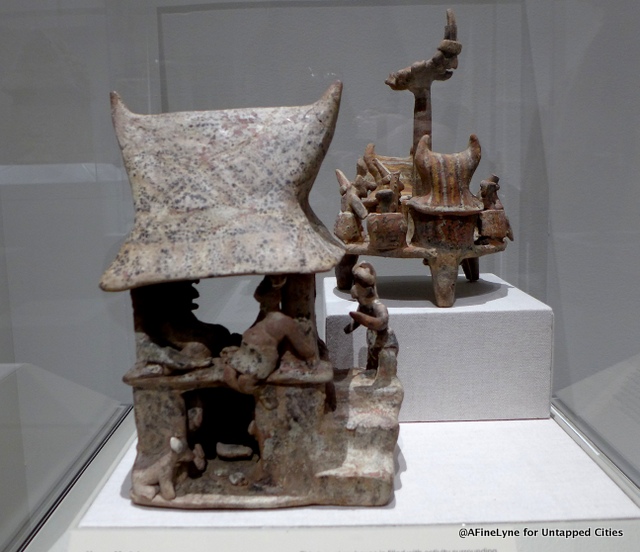 Foreground, House model c.A.D.100-300. Culture: Nayarit, Mexico, Mesoamerica
Foreground, House model c.A.D.100-300. Culture: Nayarit, Mexico, Mesoamerica
The exhibit Design for Eternity: Architectural Models from the Ancient Americas at the Metropolitan Museum of Art is the first exhibition of its kind in the United States, giving us a rare look into the traditions and practices of the Aztecs, Incas and their predecessors. The exhibit presents small architectural models created in the ancient Americas that were placed in tombs alongside jewelry and other ritual objects. It is interesting to note how similar this practice was to that of the ancient Egyptians, who lived on a different continent.
The exhibition of pre-Columbian architectural miniature models, made of stone, ceramic, wood and metal, were an important part in the funerary practice, and were representative of their daily lives. It provides a glimpse into how great civilizations that existed in what is now Central and South America lived, played and entertained from the first millennium B.C. until the arrival of Europeans in the 16th century.
 Image in public domain from Metropolitan Museum of Art. c.100B.C.-A.D.200. Culture Nayarit, Mexico
Image in public domain from Metropolitan Museum of Art. c.100B.C.-A.D.200. Culture Nayarit, Mexico
These small-scale replicas of daily life were created by artists and ranged from simple to elaborate complexes, complete with figures. The models were said to play an important role between the living, the dead and the afterlife. Arranged in chronological order, the exhibit consists of about thirty pieces on loan from museums in the United States and Peru, as well as works from the permanent collection of the Metropolitan Museum of Art. We know very little about how these artifacts survived.
In the exhibition is a ball court model, a game believed to be very much like soccer. You can see the court lined with spectators who appear to be engaged in entertainment. The model represents a central plaza with spectators watching a man in a feathered headdress at the top of a pole. The scene in the model might represent a funerary ceremony or a later ritual. In the Inca period, the royal dead were not buried. They were kept in their palaces and periodically celebrated by their descendants. Since this model was discovered about eight miles from Chan Chan, it is presumed to be a palace courtyard at Chan Chan. The Nayarit, however, were known to bury their dead under their houses so that the lower rooms were known as the tombs. Below, samples of vessels from the Moche culture, who lived on Peru’s north coast from A.D.200-800.
 Architectural vessels A.D.400-600. Culture: Moche, Peru
Architectural vessels A.D.400-600. Culture: Moche, Peru
Design for Eternity: Architectural Models from the Ancient Americas will be on view at the Metropolitan Museum of Art through September 18, 2016.
Next, discover the Top 10 Secrets of the Metropolitan Museum of Art. Get in touch with the author at AFineLyne.






